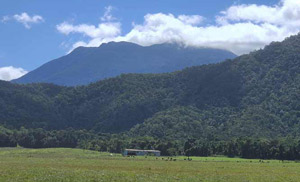There are a mind-blowing 12,000+ types of insects that call the Wet Tropics of Queensland Australia home. Obviously we can’t list them all, but here are a few interesting insects and other critters you may be lucky to spot on a visit to the Daintree Rainforest.

Peppermint Stick Insect
We’ve all been stuck in a room with someone who’s perfume is far too strong 💪👃… and even if pleasant at first sniff🌷… it can become overwhelmingly unbearable.🤢
The particularly flamboyant Peppermint Stick Insect (Megacrania batesii) is a master of clearing the room with a pungent peppermint scented liquid squirted as a defence if it feels threatened.
Another defense strategy for these amazing insects is their use of the sloping, spiky Pandanus leaves to make a quick getaway.
You might be lucky to spot one (or 2 in this case) on a pandanas plant along one of the Daintree Rainforest boardwalks on the Daintree Coast.
Don’t get too close though or you might come face to face with the peppermint wrath of the Peppermint Insect!

What did Katy Do?
Can you see me? I’m a Leaf-mimic Katydid. You might be lucky to spot me among the leaves of various rainforest plants throughout the Daintree Rainforest.
I come from the family Tettigoniidae and am a master of camouflage.

Another amazing master of camouflage
The Prickly or Spiny Katydid (Phricta spinosa) aka Spiny Tree Crickets can sometimes be spotted by a trained eye on the bark of trees in the Daintree Rainforest and other tropical rainforests of eastern Australia.
They grow to around 60mm long with females being larger than males.
In daylight hours they like to hang out completely blended in with the bark and lichen on trees. Their excellent camouflage helps protect them from predators.
They become most active at night and feed upon the foliage and bark of rainforest plants and also fruits when the opportunities arise. Both sexes are capable of jumping relatively long distances, but the light-weight males can also make use of their wings for short flights.

How many legs?
The Giant centipede (Ethmostigmus rubripes) can grow up to 20cm. They can scutter easily along both forwards and backwards without tripping over with up to 23 pairs of legs!
This venomous arthropod is Australia’s largest centipede species.
They are nocturnal hunters with a potent venom that’s toxic to both insects and mammals.
Some people who have been bitten have described the pain as extreme and lasting for days, others have said it’s no worse than a bee sting. If unluckily enough to be stung apply an ice pack to relieve the pain.
But don’t worry they spend most of their time hiding under a rock or log or somewhere else dark in the forest… just watch your step!

There be dragons!
When wandering the Daintree Rainforest boardwalks you’ll often spot dragonflies hovering around creek beds, streams and wetlands.
Dragonflies belong to the insect group Odonata. They are amazing predators and will dart around enjoying a good feed of mosquitos, gnats or other small flying insects.
Their large eyes contain up to 30,000 facets allowing for almost 360-degrees visibility enabling them to hunt by sight!
Many dragonflies in the Daintree Rainforest are brightly coloured. Their body colour becomes stronger as the insect grows older.

Prey or pray

Leaf it as this?
Have you seen one of these before?
This is a Spiny Leaf Insect (Extatosoma tiaratum) also known as Spiny Stick Insect. Belonging to the phasmids family, they are often well-camouflaged.
They feed on a variety of fresh foliage and have a facinating reproductive cycle…
It starts with a female dropping eggs individually from a tree down to the forest floor. The eggs look like plant seeds and are often collected by ants and stored in their underground nests keeping them safe from predators.
After hatching, each nymph (baby Spiny Leaf Insect) mimics the appearance of an ant and makes its way to the surface and safely to a tree.
As they grow they moult their exoskeleton multiple times. During their final moult males develop fully useable wings and straighten their abdomen to accomodate them. Females however only develop tiny unusable wings and remain curled.
Females may not have wings but they can clone themselves! 😮
They are parthenogenetic, meaning they can reproduce without mating with a male. In doing so females produce offspring which are effectively clones of herself!
You’ll find more examples of insects, butterflies, moths and spiders in our Daintree Rainforest Wildlife Gallery.
Be Amazed, Daintree Coast.











